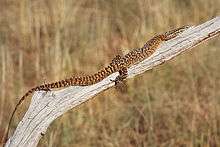Spiny-tailed monitor
The spiny-tailed monitor[1] (Varanus acanthurus), also known as the ridge-tailed monitor[2] or Ackies dwarf monitor,[3] is an Australian species of lizard belonging to the genus of monitor lizards (Varanus).
| Spiny-tailed monitor | |
|---|---|
 | |
| Scientific classification | |
| Kingdom: | Animalia |
| Phylum: | Chordata |
| Class: | Reptilia |
| Order: | Squamata |
| Family: | Varanidae |
| Genus: | Varanus |
| Subgenus: | Odatria |
| Species: | V. acanthurus |
| Binomial name | |
| Varanus acanthurus Boulenger, 1885 | |
 | |
| Distribution of the spiny-tailed monitor | |
Description
The spiny-tailed monitor, a medium-sized monitor lizard, can attain a total length of up to 70 cm (27 in). The tail is about 1.3-2.3 times as long as the head and body combined. The upper side is a rich, dark brown and painted with bright-yellowish to cream spots, which often enclose a few dark scales. Its tail is round in section and features very spinose scales. There are 70-115 scales around the middle of the body.[2] The spiny-tailed monitor is distinguished from the similar-looking species V. baritji and V. primordius by the presence of pale longitudinal stripes on the neck.[1]
Distribution and habitat
This arid-adapted[4] lizard is found in northern Western Australia, in the Northern Territory and in the eastern and northeastern parts of Queensland.[4] The spiny-tailed monitor inhabits is associated with arid rocky ranges and outcrops.[1][2] V. a. acanthurus is primarily found in North-Western Australia in the Western Territory while V. a. brachyurus can be found in Central Australia with their range extending up into the Northern Territory. V. insulanicus range is limited to a small island off the Coast of Northern Australia.[5]
Subspecies and taxonomy
The spiny-tailed monitor is part of an exclusively Australian radiation of small monitor lizards, the subgenus Odatria.[6][7]
In the past, three subspecies of V. acanthurus were recognised: The continental subspecies V. a. acanthurus and V. a. brachyurus, and V. insulanicus, that only inhabits Groote Eylandt and the islands of the Wessel group.[1][2] In 2006, the results of a study on the mtDNA of Australian monitors were published, according to which the two continental subspecies do not form natural (monophyletic), taxonomic entities. V. a. insulanicus was proven to be monophyletic, but it is more closely related to V. baritji than to other V. acanthurus. Therefore, V. a. insulanicus might represent a distinct species.[7] Wilson and Swan (2010) still accept V. a. insulanicus as a valid subspecies of V. acanthurus, which is easily distinguished from other spiny-tailed monitors by its dark colouration and more-banded pattern.[1]

Ecology
Spiny-tailed monitors are diurnal, solitary ground-dwellers. This species is most often found in its shelter, mainly under rock slabs, boulders or in rock crevices. Only rarely do they hide in spinifex.[2] As the spiny-tailed monitor has a lower level of activity compared to other monitor lizards, as well as a lower metabolic rate, it is often found in its hideout at day, and most likely it is a sit-and-wait-predator.
Diet
They prey mainly on insects, most commonly orthopterans such as grasshoppers, followed by beetles and cockroaches. Small lizards such as skinks, geckos, or dragon lizards are also eaten, making up about a third of its diet.[8] Less often, this species feeds on other insects, spiders, snails or young marsupials. Approximately 70% of its water requirement comes from food.[4]
Reproduction
In captivity, a clutch consists of up to 18 eggs. The young hatch after three to five months of incubation, and measure 15 cm (6 in). The knowledge on reproduction in the wild is sparse. Males most likely mature at 30 cm (12 in) snout-vent length, females mature at 25–36 cm (10–14 in) snout-vent length. Ovulation occurs in August and November. The eggs are deposited in self-dug tunnels.[4]
References
| Wikimedia Commons has media related to Varanus acanthurus. |
- Wilson S, Swan G. 2010. A complete guide to reptiles of Australia. New Holland Publishers, Sydney, Auckland, London, Cape Town. ISBN 978-1-877069-76-5. P 392.
- Cogger H. 2000. Reptiles & Amphibians of Australia. Ralph Curtis Publishing, Sanibel Island, Florida. ISBN 0-88359-048-4. Pp 359-361.
- "Cincinnati Zoo & Botanical Garden". Archived from the original on 2012-09-05. Retrieved 2012-08-28.
- Dryden G. 2004. Varanus acanthurus. In: Varanoid Lizards of the World (Hrsg. Pianka ER, King DR), pp 298-307. Indiana University Press, Bloomington & Indianapolis. ISBN 0-253-34366-6.
- "Ackie Monitor Care Sheet". Reptile Range. Retrieved 8 April 2020.
- Böhme W. 2003. Checklist of the living monitor lizards of the world (family Varanidae). Zoologische Verhandelingen 341, pp 3–43.
- Fitch AJ, Goodman AE, Donnellan SC. 2006. A molecular phylogeny of the Australian monitor lizards (Squamata:Varanidae) inferred from mitochondrial DNA sequences. Australian Journal of Zoology 54, p 253-269.
- Losos, Jonathan B.; Greene, Harry W. (1988-12-01). "Ecological and evolutionary implications of diet in monitor lizards". Biological Journal of the Linnean Society. 35 (4): 379–407. doi:10.1111/j.1095-8312.1988.tb00477.x. ISSN 0024-4066.